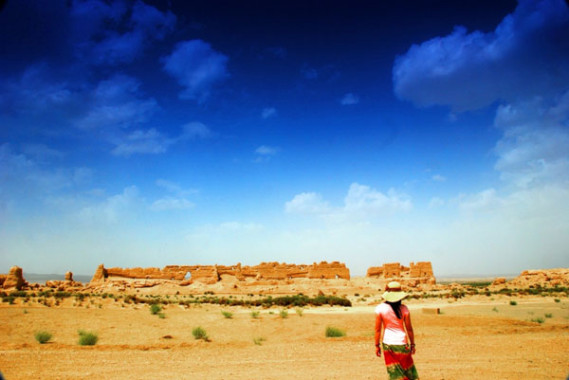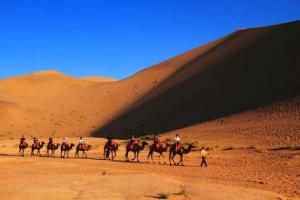Join-in Group Silk Road China Tours
About Us | Contact us | Tourist Map | Hotels | Feedback
City & Country on Silk Road Trade Routes

Overview:The Silk Road is an extensive sea & land network of related ancient trade routes from Xi'an to Rome through many contries and cities such as Syria, Turkey, Iran, Turkmenistan, Uzbekistan, Kyrgyzstan, Pakistan, China and more...
The Silk Road crosses Asia from Xi'an China to Rome in Europe. One poem calls it "The Golden Road to Samarkand". It is not really a single paved road, rather an extensive sea & land network of related ancient trade routes. So that some scholars prefer the term "Silk Routes" for it, though few were more than rough caravan tracks.
Background
Caravans have been travelling the Silk Road for over 2000 years, and Chinese silk was reaching Rome before the time of Christ. Ideas also travelled this road. Both Islam and Buddhism reached China by this route and some Silk Road areas have important relics of those religions. Various ideas from the East also reached the Islamic countries and sometimes Europe. Marco Polo followed this route, reaching China overland via Khotan and beginning his homeward journey with a ship on the Maritime Silk Road from Quanzhou (Fujiang, China) to Iran.
The Silk Routes
The Silk Road includes routes through Syria, Turkey, Iran, Turkmenistan, Uzbekistan, Kyrgyzstan, Pakistan, China and more countries. China section form Xi'an from Kashgar nearly takes up a half of the whole trade journey. As it extends westwards from the ancient commercial centers of China, the overland, intercontinental Silk Road divides into the northern and southern routes by passing the Taklimakan Desert and Lop Nur.
Northern Route
Xi'an in Shaanxi - Lanzhou and Dunhuang in Gansu - Kashgar in Xinjiang - Samarkand in Uzbekistan or Kazakhstan - Turkmenistan - Istanbul in Turkey - Rome in Italy
The northern route started at ancient China Han capital Chang'an (now called Xi'an) and travelled northwest through the Chinese province of Gansu from Shaanxi Province, and split into three further routes, two of them following the mountain ranges to the north and south of the Taklamakan Desert to rejoin at Kashgar; and the other going north of the Tian Shan mountains through Turpan, Talgar and Almaty (in what is now southeast Kazakhstan). All three divided routes eventually joined at Kashgar Xinjiang.
The routes split again west of Kashgar, with a southern branch heading down the Alai Valley towards Termez (in modern Uzbekistan) and Balkh (Afghanistan), while the other traveled through Kokand in the Fergana Valley (in present-day eastern Uzbekistan) and then west across the Karakum Desert. Both routes joined the main southern route before reaching Merv (Turkmenistan). A route for caravans, the northern Silk Road brought to China many goods such as "dates, saffron powder and pistachio nuts from Persia; frankincense, aloes and myrrh from Somalia; sandalwood from India; glass bottles from Egypt, and other expensive and desirable goods from other parts of the world." In exchange, the caravans sent back bolts of silk brocade, lacquer ware and porcelain. Another branch of the northern route turned northwest past the Aral Sea and north of the Caspian Sea, then and on to the Black Sea.
Southern Route
Xi'an in Shaanxi - Lanzhou and Dunhuang in Gansu - Kashgar in Xinjiang - Karakoram in Pakistan - Afghanistan - Iran - Syria - Anatolia in Turkey
The southern route or Karakoram route was mainly a single route running from China, through the Karakoram, where it persists to modern times as the international paved road connecting Pakistan and China as the Karakoram Highway. It then set off westwards, but with southward spurs enabling the journey to be completed by sea from various points. Crossing the high mountains, it passed through northern Pakistan, over the Hindu Kush mountains, and into Afghanistan, rejoining the northern route near Merv. From there, it followed a nearly straight line west through mountainous northern Iran, Mesopotamia and the northern tip of the Syrian Desert to the Levant, where Mediterranean trading ships plied regular routes to Italy, while land routes went either north through Anatolia or south to North Africa. Another branch road traveled from Herat through Susa to Charax Spasinu at the head of the Persian Gulf and across to Petra and on to Alexandria and other eastern Mediterranean ports from where ships carried the cargoes to Rome.
South-west Route
Xi'an in Shaanxi - Chengdu in Sichuan - Lhasa in Tibet - Kathmandu in Nepal - New Delhi in India - Sea Route or Northern Route
Xi'an in Shaanxi - Chengdu in Sichuan - Kunming in Yunnan - Burma - Bangladesh - New Delhi in India - Sea Route or Northern Route
The southwest route is believed to be the Ganges/Brahmaputra Delta which has been the subject of international interest for over two millennia. Strabo, the 1st Century Roman writer, mentions the deltaic lands: 'Regarding merchants who now sail from Egypt…as far as the Ganges, they are only private citizens...' His comments seem to be interesting since the Roman beads and other materials are being found at Wari-Bateshwar ruins, the ancient city with roots from much earlier before the Bronze Age presently being slowly excavated beside the Old Brahmaputra in Bangladesh. Ptolemy's map of the Ganges Delta, a remarkably accurate piece of mapping, showed quite clearly that his informants knew all about the course of the Brahmaputra River, crossing through the Himalayas then bending westward to its source in Tibet. It is doubtless that this delta was a major international trading center, almost certainly from much earlier than the Common Era. Gemstones and other merchandise from Thailand and Java were traded in the delta and through it. A famous Chinese archaeological writer Bin Yang, whose work, 'Between Winds and Clouds; The Making of Yunnan', published in 2004 by the Columbia University press and some earlier writers and archaeologists, such as Janice Stargardt strongly suggest this route of international trade as Sichuan-Yunnan-Burma-Bangladesh route. According to Bin Yang, especially from the 12th century the route was used to ship bullion from Yunnan (Gold and Silver being among the minerals in which Yunnan is rich), through northern Burma, into modern Bangladesh, making use of the ancient route, known as the 'Ledo' route. The emerging evidence of the ancient cities of Bangladesh, in particular Wari-Bateshwar ruins, Mahasthangarh, Bhitagarh, Bikrampur, Egarasindhur and Sonargaon are believed to be the international trade centers in this route.
The Maritime Silk Routes
Quanzhou & Fuzuou in Fujiang - Guangzhou in Guangdong - Hainan - Vietnam or Malaysia, The Philippines - Singapore - India - Red Sea - Madagascar
Ningbo - Korea - Japan


